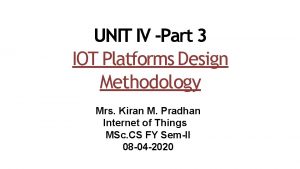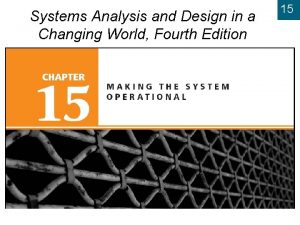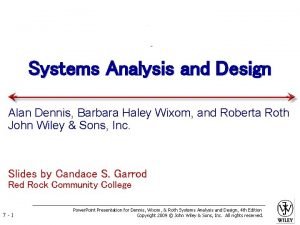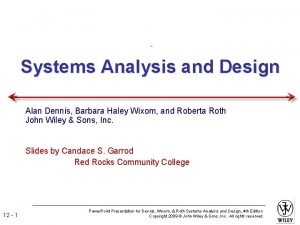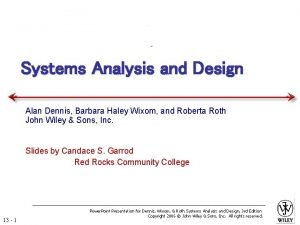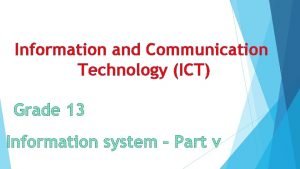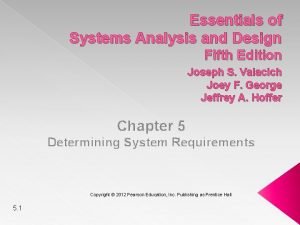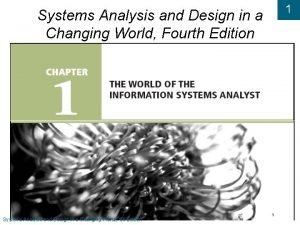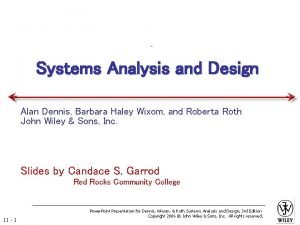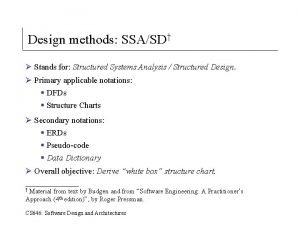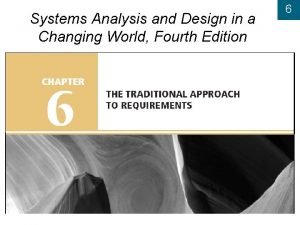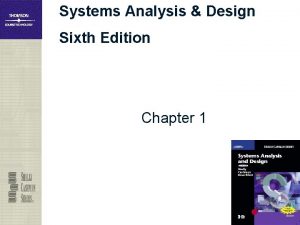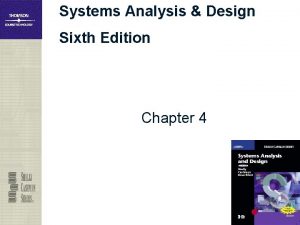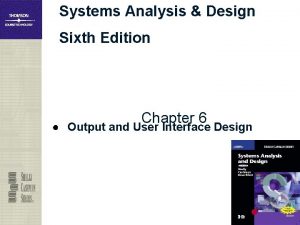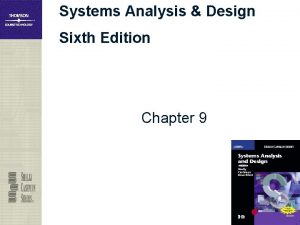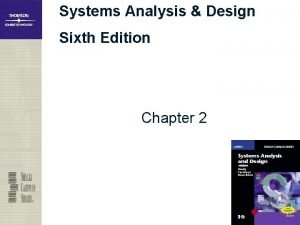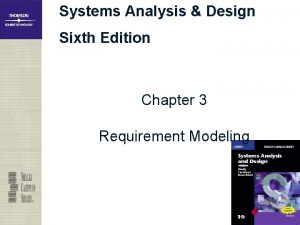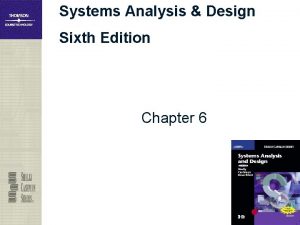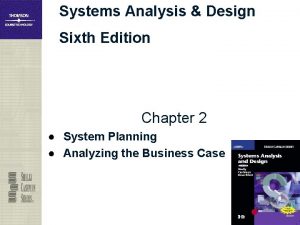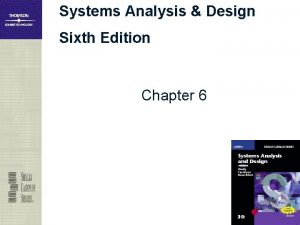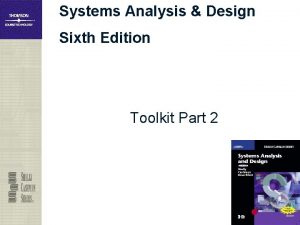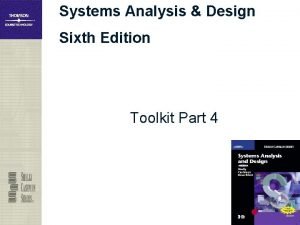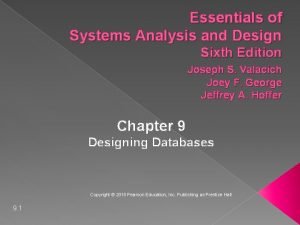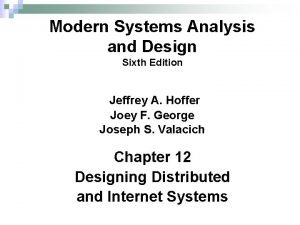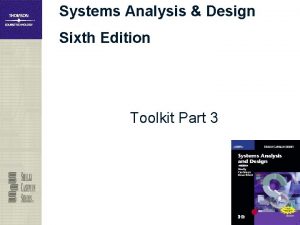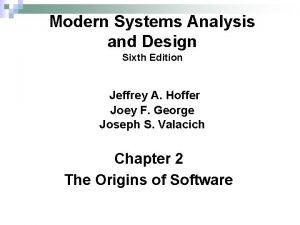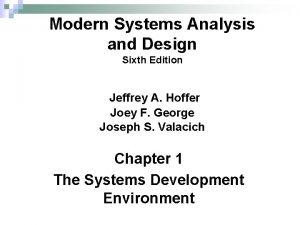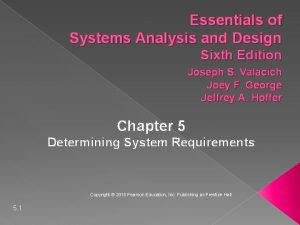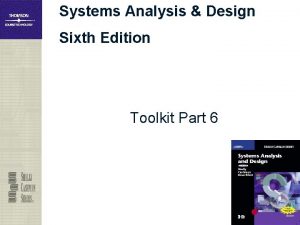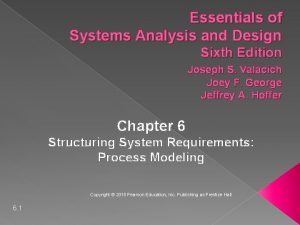Systems Analysis Design Sixth Edition Chapter 8 Chapter



















































- Slides: 51

Systems Analysis & Design Sixth Edition Chapter 8

Chapter Objectives ● Provide a checklist of issues to consider when selecting a system architecture ● Describe servers, server-based processing, clients, and client-based processing ● Explain client/server architecture, including tiers, cost-benefit issues, and performance considerations ● Describe the impact of the Internet on system architecture 2

Chapter Objectives ● Explain the difference between online and batch processing ● Define network topology, and provide examples of hierarchical, star, bus, and ring network models ● Explain network protocols and licensing issues 3

Chapter Objectives ● Explain system management tools and techniques, including performance measurement, fault management, backup, and disaster recovery ● Describe the systems design specification and explain the contents of each section 4

Introduction ● An effective system combines elements into an architecture, or design, that is flexible, cost-effective, technically sound, and able to support the information needs of the business ● System architecture translates the logical design of an information system into a physical structure that includes hardware, software, network support, processing methods, and security 5

System Architecture Checklist ● A systems analyst must approach system architecture with an overall checklist – – – – Enterprise resource planning (ERP) Initial and total cost of ownership (TCO) Scalability Web integration Legacy system interface requirements System security Processing options 6

System Architecture Checklist ● Enterprise Resource Planning (ERP) – The objective of ERP is to establish a companywide strategy for using IT resources – Describes environment – platform – Supply chain management ● Initial Cost and TCO – During the final design stage, you make decisions that will have a major impact on the initial costs and TCO for the new system – You should review all previous cost estimates 7

System Architecture Checklist ● Initial Cost and TCO – Ask questions like the following • If in-house development was selected as the best alternative initially, is it still the best choice? • If a specific package was chosen initially, is it still the best choice? • Have any new types of outsourcing become available? – Answers might affect the initial cost and TCO for the proposed system 8

System Architecture Checklist ● Scalability – Scalability, also called extensibility – Especially important in implementing systems that are volume-related, such as transaction processing systems ● Web Integration – An information system includes application programs, also called applications – Web-centric 9

System Architecture Checklist ● Legacy System Interface Requirements – The new system might have to interface with one or more legacy systems – Interfacing a new system with legacy systems involves analysis of data formats and compatibility – The analyst must know if the new application eventually will replace the legacy system 10

System Architecture Checklist ● Processing Options – In planning the architecture, designers also must consider how the system will process data online or in batches – 24/7 – Provision must be made for backup and speedy recovery in the event of system failure 11

System Architecture Checklist ● Security Issues – Security is a concern at every stage of system development – The systems analyst must consider security issues that relate to system design specifications and determine how the company will address them – Web-based systems introduce additional security concerns 12

Planning the Architecture ● Every information system involves three main functions: data storage and access methods, application programs to handle the processing logic, and an interface that allows users to interact with the system ● Depending on the architecture, the three functions are performed on a server, on a client, or are divided between the server and the client 13

Planning the Architecture ● Servers – – – Server Clients Mainframe architecture Centralized system Background • Data processing center • Users had no input or output capability, except for printed reports that were distributed by a corporate IT department 14

Planning the Architecture ● Servers – Server-based processing • Terminal • In a centralized design, the remote user’s keystrokes are transmitted to the mainframe, which responds by sending screen output back • An Internet-based retail operation might use centralized data management • As server technology evolved, terminal technology also has changed dramatically 15

Planning the Architecture ● Clients – As PC technology exploded in the 1980 s, microcomputers quickly appeared on corporate desktops – Users found that they could run their own word processing, spreadsheet, and database applications – Most companies linked the stand-alone computers into networks 16

Planning the Architecture ● Clients – Stand-Alone Computing – Local and wide area networks • Most companies resolved the problems of standalone computing by joining clients into a local area network (LAN) • A wide area network (WAN) spans long distances and can connect LANs that are continents apart • The network is transparent • Distributed systems 17

Planning the Architecture ● Clients – Client-based processing • In a typical LAN, clients share data stored on a local server • In a file server design, also called a file sharing architecture, an individual LAN client has a copy of the application program installed locally, while the data is stored on a central file server • A file server design requires significant network resources 18

Client/Server Architecture ● Today’s interconnected world requires an information architecture that spans the entire enterprise ● Whether you are dealing with a departmental network or a multinational corporation, as a systems analyst you will work with a distributed computing strategy called client/server architecture 19

Client/Server Architecture ● Overview – Client/server architecture 20

Client/Server Architecture ● Overview – Legacy data ● Client/Server Design Styles – Client/server designs can take many forms, depending on the type of server and the relationship between the server and the clients 21

Client/Server Architecture ● Types of Clients: Fat and Thin – Fat client - thick client – Thin client – Most IT experts agree that thin client designs provide better performance, because program code resides on the server, near the data – In contrast, a fat client handles more of the processing and must access and update the data more often 22

Client/Server Architecture ● Client/Server Tiers – Two-tier design – Three-tier design – Think of the middle layer as an application server, because it provides the application logic, or business logic – Three-tier designs also are called n-tier designs – The middle layer is more efficient and costeffective in large-scale systems 23

Client/Server Architecture ● Middleware ● Cost-Benefit Issues – Client/server systems enable the firm to scale the system in a rapidly changing environment – Client/server computing also allows companies to transfer applications from expensive mainframes to less expensive client platforms – Client/server systems reduce network load and improve response times 24

Client/Server Architecture ● Client/Server Performance Issues – Client/server architecture does involve performance issues that relate to the separation of server-based data and networked clients – In contrast to the centralized system, a client/server design separates applications and data – Client/server systems must be designed so the client contacts the server only when necessary – Distributed database management system (DDBMS) 25

Internet-Based Architecture ● The Internet has had an enormous impact on system architecture ● To support this trend, systems analysts must suggest e-commerce strategies that apply available technology and meet their company’s business requirements 26

Internet-Based Architecture ● Developing E-Commerce Solutions In. House – If you decide to proceed with an in-house solution, you must have an overall plan to help achieve your goals – An in-house solution usually requires a greater initial investment, but provides more flexibility for a company that must adapt quickly in a dynamic e-commerce environment 27

Internet-Based Architecture ● Packaged Solutions and E-Commerce Service Providers – Many vendors offer turnkey systems for companies – Another alternative is to use an application service provider (ASP) – Must consider whether the advantage of lower initial cost outweighs the disadvantage of reduced flexibility later on 28

Internet-Based Architecture ● Corporate Portals – A portal is an entrance to a multifunction Web site – A corporate portal can provide access for customers, employees, suppliers, and the public 29

Processing Methods ● Online Processing – – An online system handles transactions when and where they occur and provides output directly to users Online processing also can be used with fileoriented systems 30

Processing Methods ● Online Processing – Online processing systems have four typical characteristics: 1. The system processes transactions completely when and where they occur 2. Users interact directly with the information system 3. Users can access data randomly 4. The information system must be available whenever necessary to support business functions 31

Processing Methods ● Batch Processing – In a batch processing system, data is collected and processed in groups, or batches ● Combined Online and Batch Processing – Point-of-sale (POS) 32

Network Models ● The OSI Reference Model – The OSI model consists of seven layers • Application layer: provides network services requested by local workstation • Presentation layer: assures that data is uniformly structured and formatted for network transmission • Session layer: defines control structures that manage the communications link between computers • Transport layer: provides reliable data flow and error recovery 33

Network Models ● The OSI Reference Model – The OSI model consists of seven layers • Network layer: defines network addresses and determines how data is routed over the network • Data link layer: defines specific methods of transmitting data over the physical layer, such as defining the start and end of a data block • Physical layer: contains physical components that carry data, such as cabling and connecters 34

Network Models ● Network Modeling Tools – As you translate the OSI logical model into a physical model of the networked system, you can use software tools, such as Microsoft Visio, which is a multipurpose drawing tool, to represent the physical structure and network components 35

Network Models ● Network Topology – Hierarchical network 36

Network Models ● Network Topology – Star network 37

Network Models ● Network Topology – Bus network 38

Network Models ● Network Topology – Ring network 39

Network Models ● Network Protocols and Licensing Issues – The network must use a protocol – A popular network protocol is Transmission Control Protocol/Internet Protocol (TCP/IP) – A familiar example of a TCP/IP protocol is the file transfer protocol (FTP) 40

Network Models ● Wireless Networks – A wireless local area network, or WLAN – 802. 11 network standard – Institute of Electrical and Electronics Engineers (IEEE) – 802. 11 b – 802. 11 High Rate – Wi-Fi – Although they have many advantages, wireless networks pose special concerns with regard to system security 41

System Management and Support ● Performance Management – Performance management tools are designed to collect information about system resources and activity levels – Firms such as Net. Scout Systems offer comprehensive performance management packages – The Net. Scout Web site mentions studies that show network delays cost the industry more revenue than actual stoppages 42

System Management and Support ● Fault Management, Backup, and Disaster Recovery – Fault management – Backup and disaster recovery • • Backup Recovery Disaster recovery plan Backup and recovery planning depends on the type of system involved 43

System Management and Support ● Fault Management, Backup, and Disaster Recovery – Backup and disaster recovery • Another common strategy is to use a RAID (redundant array of independent disks) system • RAID systems are called fault-tolerant • Experienced IT professionals often note that the three most important system security tools are backup, and more backup 44

System Management and Support ● Fault Management, Backup, and Disaster Recovery – Backup and disaster recovery • Log file or journal file • Business insurance can help offset expenditures • File retention laws and regulations apply to company data • If a government rule specifies that a record of all payments to the company must be kept for three years, then your design must retain the data for that period 45

Systems Design Completion ● System Design Specification – – System design specification Technical design specification Detailed design specification The system design specification is the baseline against which the operational system will be measured – The system design specification varies in length 46

Systems Design Completion ● System Design Specification – A typical system design specification uses a structure similar to the following: 1. 2. 3. 4. 5. 6. Executive summary System components System environment Implementation requirements Time and cost estimates Appendices 47

Systems Design Completion ● User Approval – Users must review and approve the interface design, report and menu designs, data entry screens, source documents, and other areas of the system that affect them – Other IT department members also need to review the system design specification – When the system design specification is complete, you distribute the document to a target group of users, IT department personnel, and company management 48

Systems Design Completion ● Presentations – The first presentation is to the systems analysts, programmers, and technical support staff members – Your next presentation is to department managers and users from departments affected by the system – The final presentation is for company management – Key objective: to obtain management’s approval and support for the next development step 49

Chapter Summary ● The analyst must consider enterprise resource planning, initial cost and TCO, scalability, Web integration, legacy interface requirements, security, and processing options ● System security is an important concern ● An architecture requires servers and clients ● Compared to file server designs, client/server systems are more scalable and flexible 50

Chapter Summary ● Networks allow the sharing of hardware, software, and data resources in order to reduce expenses and provide more capability to users ● The way a network is configured is called the network topology ● The system design specification presents the complete systems design for an information system ● Chapter 8 Complete 51
 Mmodation
Mmodation Rubber baby buggy bumpers tongue twister lyrics
Rubber baby buggy bumpers tongue twister lyrics Systems analysis and design 5th edition
Systems analysis and design 5th edition Modern systems analysis and design 7th edition
Modern systems analysis and design 7th edition Biochemistry sixth edition
Biochemistry sixth edition Computer architecture a quantitative approach sixth edition
Computer architecture a quantitative approach sixth edition Automotive technology principles diagnosis and service
Automotive technology principles diagnosis and service Automotive technology sixth edition
Automotive technology sixth edition Citation sample pdf
Citation sample pdf Computer architecture a quantitative approach sixth edition
Computer architecture a quantitative approach sixth edition Precalculus sixth edition
Precalculus sixth edition Rational people think at the margin
Rational people think at the margin Computer architecture a quantitative approach sixth edition
Computer architecture a quantitative approach sixth edition Iot system design methodology
Iot system design methodology Hamlet's 6th soliloquy
Hamlet's 6th soliloquy Using mis 10th edition
Using mis 10th edition Mis
Mis The sixth extinction chapter 3 summary
The sixth extinction chapter 3 summary Systems analysis and design in an age of options pdf
Systems analysis and design in an age of options pdf System analysis
System analysis Systems analysis and design in a changing world
Systems analysis and design in a changing world System analysis and design in a changing world
System analysis and design in a changing world Alan dennis system analysis design
Alan dennis system analysis design Sad system analysis and design
Sad system analysis and design Structured systems analysis and design method
Structured systems analysis and design method Modern systems analysis and design
Modern systems analysis and design Kendall and kendall system analysis and design
Kendall and kendall system analysis and design System analysis and design dennis
System analysis and design dennis Systems analysis and design alan dennis
Systems analysis and design alan dennis Systems analysis and design alan dennis
Systems analysis and design alan dennis Systems analysis and design alan dennis
Systems analysis and design alan dennis Systems analysis and design alan dennis
Systems analysis and design alan dennis Systems analysis and design alan dennis
Systems analysis and design alan dennis Systems analysis and design alan dennis
Systems analysis and design alan dennis Ssadm
Ssadm Radar systems analysis and design using matlab
Radar systems analysis and design using matlab Object-oriented systems analysis and design using uml
Object-oriented systems analysis and design using uml A modern approach to systems analysis and design
A modern approach to systems analysis and design System analysis and design kendall
System analysis and design kendall System analysis and design by kendall
System analysis and design by kendall System analysis and design in a changing world
System analysis and design in a changing world Systems analysis and design in a changing world
Systems analysis and design in a changing world Systems analysis and design in a changing world
Systems analysis and design in a changing world Systems analysis and design alan dennis
Systems analysis and design alan dennis Systems analysis and design alan dennis
Systems analysis and design alan dennis Systems analysis and design alan dennis
Systems analysis and design alan dennis Structured system of communication
Structured system of communication Essentials of systems analysis and design
Essentials of systems analysis and design Systems analysis and design in a changing world
Systems analysis and design in a changing world Systems analysis and design alan dennis
Systems analysis and design alan dennis List the five basic steps of ssa/sd process
List the five basic steps of ssa/sd process Systems analysis and design in a changing world
Systems analysis and design in a changing world













